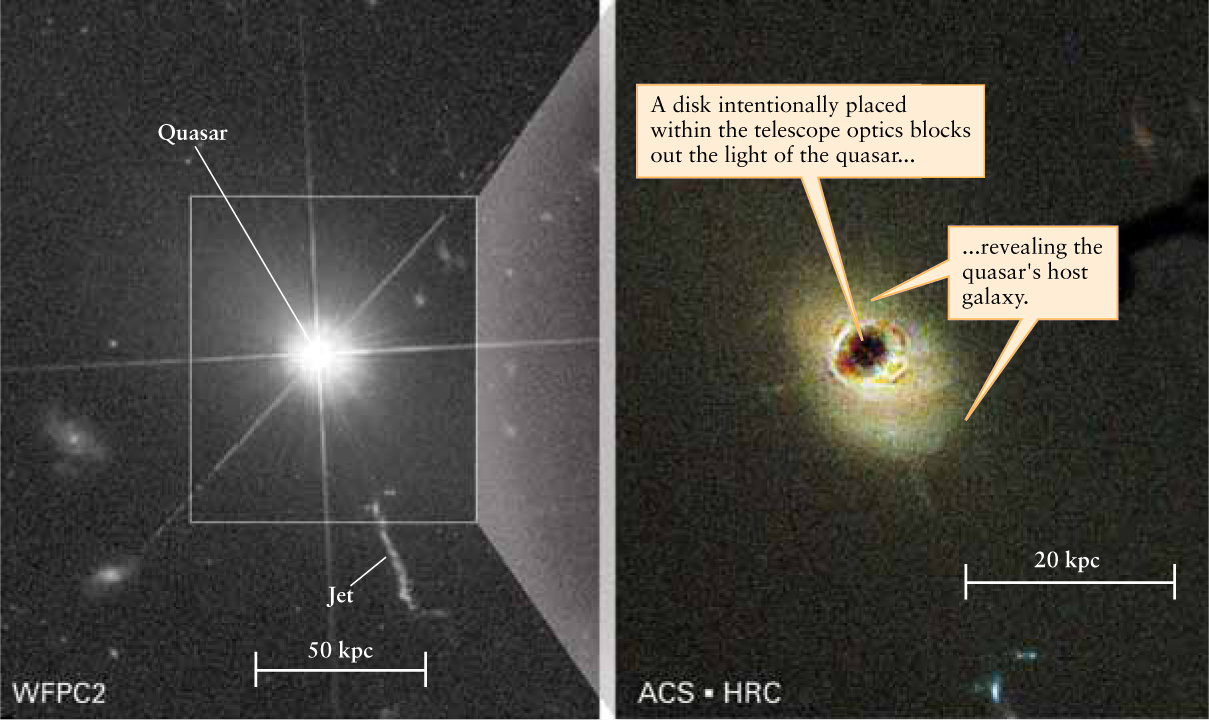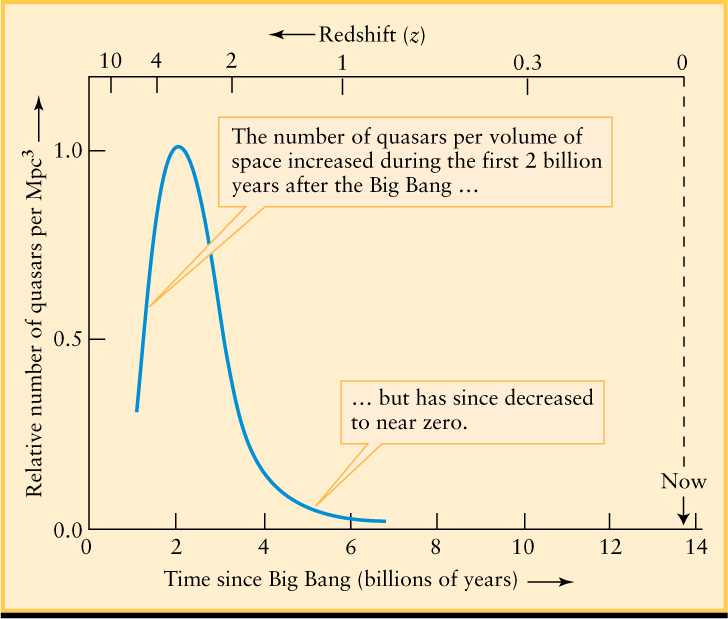24-1 Quasars are the ultraluminous centers of distant galaxies
The discovery of quasars begins in the Illinois backyard of Grote Reber, a radio engineer who built the first true radio telescope in 1936. One of the objects he discovered is called Cygnus A; a modern radio and optical image of this quasar is shown in Figure 24-1. The object’s thin jets shoot matter well beyond its host galaxy; to appreciate the scale, consider that about four Milky Way galaxies could fit between the ends of the two lobes in Cygnus A.

Examining the spectra of quasars revealed that they are immensely distant
In a visible-wavelength image, a distant quasar often appears as a point source of light, like a star, because the host galaxy containing the quasar is so far away that the galaxy’s light is not easily observed (Figure 24-2). Along with intense radio emission, these properties led to the name “quasar,” which means quasi-stellar radio source.

A Quasar and Its Host Galaxy (a) Appearing pointlike, a quasar can look like a star in images. In this HST image, the bright glare of a quasar named 3C 273 hides its fainter host galaxy. Quasar 3C 273 also has a jet seen in visible light, although quasar jets are usually seen at radio wavelengths. (b) Using a special technique, the quasar is blocked out to reveal the host galaxy.
While the visible light from a quasar might appear pointlike, the way a star does, its spectrum tells a very different story. Stars, and the galaxies they make up, show absorption lines in their spectra. Quasars, on the other hand, show strong emission lines.
Clues from Emission Lines

Although quasars were clearly oddballs, many astronomers thought they were just strange stars in our own Galaxy. A breakthrough occurred in 1963, when Maarten Schmidt at Caltech took another look at the emission lines of the quasar 3C 273 (Figure 24-3). Emission lines are caused by excited atoms, which emit radiation at specific wavelengths unique to each atom (see Figure 6-21). However, the lines of quasar 3C 273 did not match the known emission line wavelengths of hydrogen (or any other known atoms or molecules), so astronomers could not identify what quasars were made of.
Schmidt realized that four of 3C 273’s brightest emission lines are positioned relative to one another in precisely the same way as four common emission lines of hydrogen (these are the Balmer lines; see Figure 5-24). However, these emission lines from 3C 273 were all shifted to much longer wavelengths than had ever been seen in the Balmer lines before. Were these lines really from hydrogen, but Doppler-shifted from an object receding away at great speed? Schmidt determined that 3C 273 has a redshift of z = 0.158, corresponding to a recessional velocity equal to 16% of the speed of light (44,000 km/s). No star could be moving this fast and remain within our Galaxy for very long. Hence, Schmidt concluded that 3C 273 could not be a nearby star, but must lie outside the Milky Way.
According to the Hubble law, the recessional velocity of 3C 273 implies that its present distance from us is 2 billion light-years; that is over 800 times farther away from us than the Andromeda Galaxy! To be detected at such distances, 3C 273 must be an extraordinarily powerful source of both visible light and radio emission.
The most luminous quasars emit 100,000 times more radiation than the entire Milky Way Galaxy
A quasar’s luminosity can be calculated from its apparent brightness and distance using the inverse-square law (see Section 17-2). For example, 3C 273 has a luminosity of about 1040 watts, which is equivalent to 2.5 × 1013 (25 trillion) Suns. (The Sun’s luminosity is L⊙ = 3.90 × 1026 watts.) Generally, quasar luminosities range from about 1038 watts up to nearly 1042 watts. For comparison, a typical large galaxy, like our own Milky Way, shines with a luminosity of 1037 watts, which equals 2.5 × 1010 (25 billion) Suns. Thus, a bright quasar can be many thousands of times more luminous than our entire Milky Way Galaxy!
The rapid variability of active galactic nuclei tells us that they must be very small
Quasars are members of a larger class of objects called active galactic nuclei, or AGN (the singular form, active galactic nucleus, is also called an AGN). AGN include a range of similar objects that, technically speaking, are not all luminous enough to be called quasars. Nonetheless, all AGN are powered by hot gas accreting around a supermassive black hole, and astronomers often use the term quasar and AGN interchangeably. If the host galaxy that contains an AGN can be easily observed, the object is called an active galaxy. If the active galaxy emits strongly at radio wavelengths, as in the case of Cygnus A in Figure 24-1, the AGN is called a radio galaxy.
CONCEPT CHECK 24-1
What are two main differences between the spectra of a star and a quasar?
Here are three differences: A quasar has emission lines, whereas a star has absorption lines. A quasar also emits more strongly than a star in the radio and X-ray wavelengths. The Doppler shift of spectral lines (whether emission or absorption) is much larger for quasars than for the stars in our Galaxy, indicating that quasars recede at much higher speeds than stars in our Galaxy.
Quasars: High Redshifts, Extreme Distances
More than 200,000 quasars have been discovered. Most quasars have redshifts of 0.3 or more, which implies that they are more than 3 billion light-years from Earth. Because there are no quasars with small redshifts, it follows that there are no nearby quasars. The nearest one is some 800 million ly from Earth. Furthermore, light takes time to travel across space, so when we observe a very remote object with a large redshift, we are seeing an image propagating from the remote past. Hence, the absence of nearby quasars means that the era of quasars ended long ago. Indeed, the number of quasars began to decline precipitously roughly 10 billion years ago. Quasars were a common feature of the universe in the distant past, but there are none in the present-day universe (Figure 24-4). Quasars not only occurred early in our universe, but whenever they occurred, their brief lifetimes were only about 1% as long as the lives of their host galaxies.

CONCEPT CHECK 24-2
From Figure 24-4, about how old was the universe when quasars were most abundant? What is the approximate redshift of objects from this time?
The universe was around 2 billion years old when quasar activity peaked, and that time corresponds to a redshift z of around 3.
CONCEPT CHECK 24-3
Why can we say that any quasar observed from Earth today must have been very luminous when its light was emitted?
The farther away an object is observed, the lower its apparent brightness. The redshifts in Figure 24-5 all correspond to very distant objects that can only be observed because they were very luminous at the early times and remote distances when they shined bright.